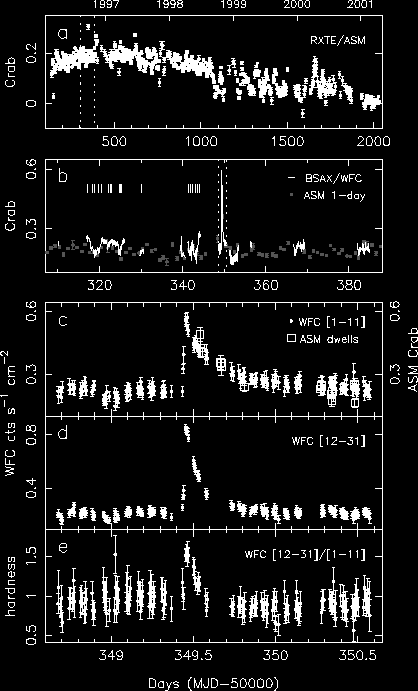

A neutron star in the constellation Ophiuchi exhibited an extremely energetic thermonuclear explosion in X-rays. The explosion was detected with the SRON-built BeppoSAX Wide Field Cameras on September 24th, 1996. The neutron star is one of the two stars in a binary system called 'KS1731-260' which was discovered in 1989 with COMIS (also built by SRON).
A neutron star is as massive as the Sun but the size as the city of Amsterdam or Utrecht. When in a binary system, it may happen that mass is transferred from the companion star to the neutron star. This material, mainly consisting of hydrogen and helium, builds up as time passes and circumstances may arise that it develops a nuclear chain reaction resulting in a natural thermonuclear H-bomb lasting approximately one minute. Such explosions on neutron stars are quite common. The Wide Field Cameras have detected about 2500 explosions from about 75 neutron stars in our Galaxy in 5 years of observations. However, last year a remarkable discovery was made by Remon Cornelisse who is a graduate student at Utrecht University (UU) and affiliated to SRON: a thermonuclear explosion that lasted for a few hours instead of just one minute, with an enormous yield thousand times larger than for the common explosions. Since they were never seen before, such events must be very rare. Theoretical work on explaining them is continuing and appears to concentrate on introducing carbon as alternative nuclear fuel to hydrogen and helium. Thereby, nature presents us with a novel kind of bomb: the thermonuclear carbon bomb.
Astrophysicists have realized this a completely new physical phenomenon. This realization has prompted deep scrutiny of new as well as old X-ray data which resulted in the discovery of 6 more events in data from the Wide Field Cameras and instruments on the Rossi X-ray Timing Explorer. One of those involves KS1731-260. Now it turns out that the event coming from this double star is the record holder in terms of duration (12 hours). Erik Kuulkers of SRON and UU and colleagues have analyzed this event and the publication of their results is scheduled in the journal 'Astronomy and Astrophysics'.

a. RXTE/ASM (1.5-12 keV) light curve of KS1731-260 from 1996 January 6 (MJD50088) to 2001 May 1 (MJD52030). The data shown are two-day averages and normalized to the count rate of the Crab (75 cts/s/SSC); only intervals with more than one dwell per day were included. b. The BeppoSAX/WFC (2-28 keV) data during the interval 1996 August 12 to November 1 (MJD50307-50388; marked by the dotted lines in panel a.). Data points (typically averages per satellite orbit) which were less than half a day apart are connected to guide the eye, and are normalized to the Crab (2 cts/s/cm2). The gray data points are the one-day averages (with more than one dwell per day) of the RXTE/ASM in the same interval. A long X-ray flare in the WFC data is seen just before MJD50350 (1996 September 24). The vertical tickmarks indicate the times of the 20 X-ray bursts seen with the WFC. They all occur before the flare. c-e. WFC light curves around the flare (marked by dotted lines in panel b) for channels 1-11 (2-5 keV; c.) and 12-31 (5-28 keV; d), and the hardness ratio of the two above defined energy bands (e). The time resolution is 5 min. Overplotted in c with open squares are the data from individual RXTE/ASM dwells. From Kuulkers et al., A&A, in press (2001)